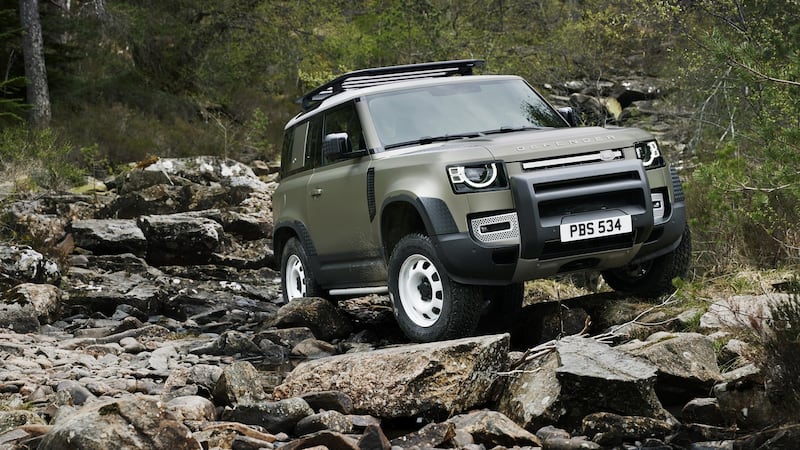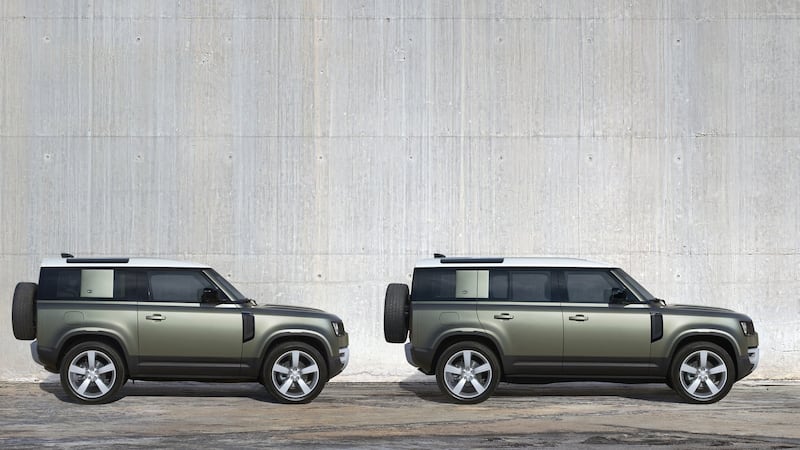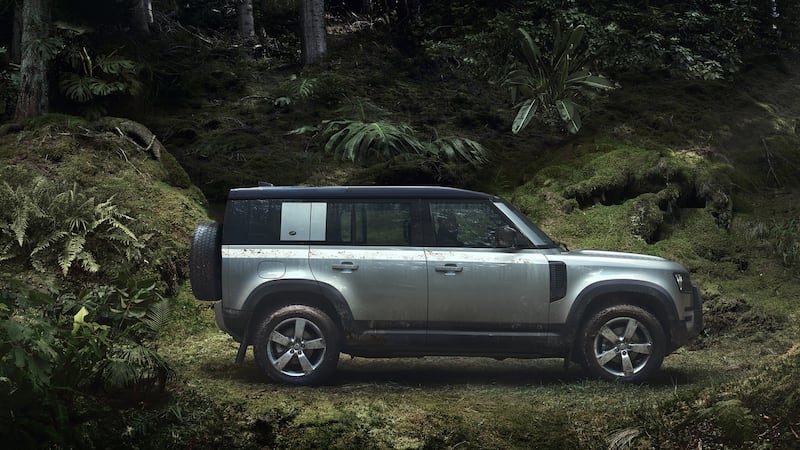How do you defend a simple symbol of your past against time and technology? Can you take the most basic of motoring vehicles and make it relevant for the connected age without sacrificing it’s heritage?
On a timeline of mobility, the previous Land Rover Defender was closer to the horse than to any of the high-tech new cars being launched these days. It was hardware, it was a motoring workhorse. And with that it garnered a reputation for earnest, honest motoring.
Its beauty, for many owners, was that it was basic. Things that broke could be fixed. And if you happened to be closer to Kinshasa than Kinnegad, then any half-decent mechanic with a wrench could usually get the Defender back on the road. And it differed from the rest of the Land Rover range in that it garnered a reputation for reliability.
Forget reviving a retro Mini or breathing new life into the Beetle. When this chapter of automotive history is written and if Land Rover pull this off, making the Defender relevant for the modern era will be a marketing and engineering feat that will top them all.
The Defender was never a vehicle to turn away from a challenge, but this is arguably its greatest one yet. Jaguar Land Rover (JLR) has updated this cornerstone of its heritage, at a time when the stakes could not be higher. Global sales are slumping, there are massive demands for high-cost research into electric power and autonomous technology, all against a backdrop of threats from tariffs and trade wars. And that's before you dare to mention Brexit.
The reality is that the real growth market in SUVs isn’t really in the utilitarian farming sector. It’s in rugged looking road-going hatchbacks. Not glorified tractors. And for all its talents off the road, the Defender was pretty dreadful to drive on the tarmac.
The criteria for this relaunch therefore was simple, yet incredibly complex. Create a successor to a vehicle that is the bedrock of the brand’s heritage, a model upon which much of the rest of its marketing pitch is built.
It must be the most rugged off-roader around, it must be styled as a homage to the past, but include all the latest safety technology and wifi wizardry. It needs to retain all that off-road agility but be decent on the road as well.
You can see why so many past attempts were shelved. Yet four years after production ended for the car that started its days in post-War Amsterdam in 1948, Land Rover has finally pulled the camouflage sheets off its new tank.
It certainly looks the part, retaining the simple, rather boxy profile of the past. But it’s also got a lot more retro character. Thanks to stylised LED lighting, it actually looks like its come to life from the drawing board at Pixar of its next Cars movie.
The styling reflects the off-road character of the car. The decision to hang the spare wheel off the back hinged door is officially for practical off-road reasons, but also, one suspects, for a bit of romantic adventure imagery as well, harking back to the days when a Defender was a common sight on the Serengeti.
Boasting about its rugged practicality, executive director of product engineering Nick Rogers says the roof can take 300kgs when the car is static - meaning three adults can pitch tent up there at night - and up to 168kgs when on the move.

It can wade in water up to 900mm deep, and more if you don't mind taking some water in the cabin as a bit of ballast to stop you from floating away. It can tow the maximum legal limit in every country it's sold, which means 3.5 tonnes in Europe. It can climb a rock face of up to a 45 degree angle, with ground clearance of 290mm. It has permanent four-wheel drive of course, with a central and rear diff lock, and a solid shield across the bottom of the car that's helpful for aerodynamics but also for being able to slide over the sand dunes and snow drifts without getting stuck.
According to Nick Collins, the Defender's vehicle line director, "an example of one of our toughest sign-off tests was to get the Defender to overcome hitting a 200mm high square-edged kerb at 40km/h. Now if you happen to be unlucky enough to be the test driver of that car, that's quite an extreme input. That specific test will generate 7 tonnes of load through the suspension, through the links and into the body structure." And the new Defender can cope. This is heavy duty off-roading. Impressed yet?
But there’s more. Land Rover promises this Defender is just as much fun on the road. Collins admits the past generation “had some compromises” when it came to on-road driving, but assures us this car delivers as an everyday family car for commuting as much as a commando in the mud and dirt.
But to really work the new Defender must capture the interest of the urban warriors. In this in mind, two of the exterior colour options are offered with a sating wrap finish, a plastic coating that gives a distinctive finish to the vehicle, but also has a rather unique feature in that under heat it closes up minor scratches and scrapes. It can also be removed or replaced.
Inside there’s a world of improvements. For a start the shorter wheelbase 90 version can come with a so-called “buddy seat” option that folds up in the front between the driver and passenger, from being a central console to being a usable seat. That converts this three-door Defender into a six seater. That’s impressive for a car that has a shorter wheelbase than an Audi A3. The longer 110 five-door version is offered with either five or seven seats.

All the modern creature comforts are on offer, just in a more rugged format. Bolts are visible in many spots with Land Rover opting to embrace the metal framework of the car rather than encase it in plastic covers, which only end up rattling or falling loose as the car ages, particularly in the rough and tumble world of everyday Defender life.
Under the bonnet, two engines will power the new car: a 3-litre petrol with 295bhp and a 2-litre diesel with either 197bhp or 237bhp. Coming soon after will be a mild hybrid version of the petrol and a plug-in hybrid version will arrive in a year’s time.
This brings us to the tech, a word you never heard mentioned in the same sentence as the previous car. If you got an FM/AM radio in the car you were high-tech. The new Defender has touchscreen controls, a wealth of cameras and safety tech, infotainment screens and more recharging ports than an Apple store. The key criteria here will be trust. Land Rover assures anyone who will listen that this tech is as rugged and reliable as the Defender itself. Time will tell.
On the issue of connectivity, the Defender is, constantly connected to the cloud via a prepaid SIM that Land Rover engineers assure us won’t cost the motorist in terms of connection costs. This lets the car be constantly updated with software upgrades and fixes. But the key is the promise of high-speed processing power on board, that the engineers say will deliver the sort of immediate responses we get from smartphone and tablet computer interfaces these days.
And among the new tech features that can be delivered with this higher processing power is an impressive 360-degree view of the car from the perspective of someone looking at it from outside. Thanks to high-powered computer processing power on board, the images effectively give the view from what Land Rover refers to as a scout, standing a few metres from the car guiding the driver from outside the vehicle. You can swipe the screen to get a full view all around the vehicle, from all angles. It’s certain to be incredibly useful when traversing rocky ground or even when trying to tackle the urban jungle of tight, modern car parks.

There are no Irish prices for the new Defender as yet, and much will depend on the Budget, but prices in the UK start at £45,240 for the entry level 90 version, with the commercial versions - due later in the year - starting at £35,000 excluding VAT. As simple guesswork we expect the new Defender could to be starting close to €60,000 when it comes to an Irish launch. But again that’s pure guesswork at this stage.
Faced with the daunting challenge of delivering a new Defender, it’s unsurprising that there’s an air of nervousness amongst the Land Rover engineers. And the proof will be garnered from behind the wheel. First impressions, though, suggest the Defender may well have overcome its greatest challenge yet.




















